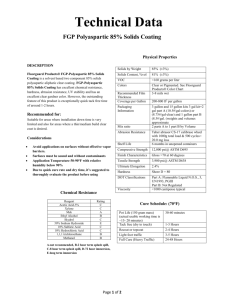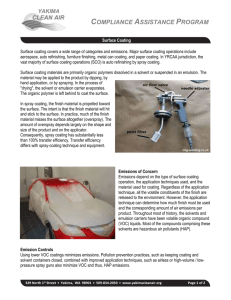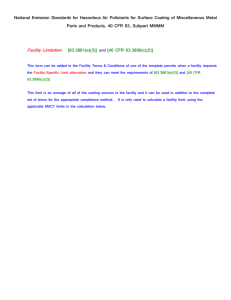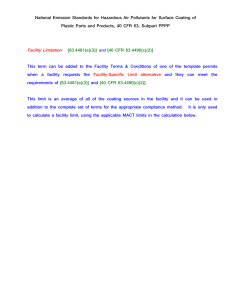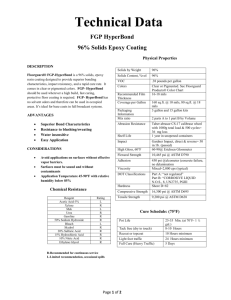National Emission Standards for Hazardous Air Pollutants for
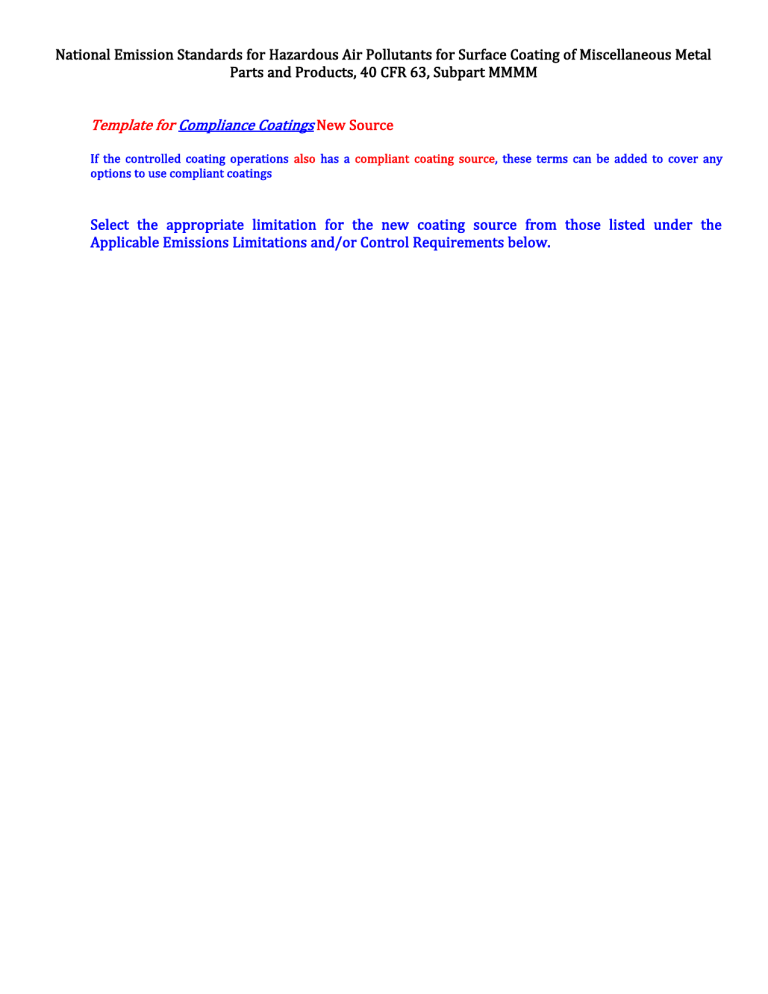
National Emission Standards for Hazardous Air Pollutants for Surface Coating of Miscellaneous Metal
Parts and Products, 40 CFR 63, Subpart MMMM
Template for Compliance Coatings New Source
If the controlled coating operations also has a compliant coating source , these terms can be added to cover any options to use compliant coatings
Select the appropriate limitation for the new coating source from those listed under the
Applicable Emissions Limitations and/or Control Requirements below.
I.
A. State and Federally Enforceable Section
I. Applicable Emissions Limitations and/or Control Requirements
The organic HAP emissions from the new or reconstructed general use coatings operations shall not exceed:
0.23 kg/liter of coating solids used during each rolling, 12-month period; or
1.9 lbs/gal of coating solids used during each rolling, 12-month period.
[40 CFR 63.3890(a)(1)]
The organic HAP emissions from the new or reconstructed high performance coatings operations shall not exceed:
3.3 kg/liter of coating solids used during each rolling, 12-month period; or
27.5 lbs/gal of coating solids used during each rolling, 12-month period.
[40 CFR 63.3890(a)(2)]
The organic HAP emissions from the new or reconstructed magnet wire coatings operations shall not exceed:
0.050 kg/liter of coating solids used during each rolling, 12-month period; or
0.44 lb/gal of coating solids used during each rolling, 12-month period.
[40 CFR 63.3890(a)(3)]
The organic HAP emissions from the new or reconstructed rubber-to-metal coatings operations shall not exceed:
0.81 kg/liter of coating solids used during each rolling, 12-month period; or
6.8 lbs/gal of coating solids used during each rolling, 12-month period.
[40 CFR 63.3890(a)(4)]
The organic HAP emissions from the new or reconstructed extreme performance fluoropolymer coatings operations shall not exceed:
1.5 kg/liter of coating solids used during each rolling, 12-month period; or
12.4 lbs/gal of coating solids used during each rolling, 12-month period.
[40 CFR 63.3890(a)(5)]
Additional Terms and Conditions
1. The permittee shall comply with the applicable provisions of the National Emissions
Standards for Hazardous Air Pollutants (NESHAP) for Surface Coating of Miscellaneous
Metal Parts and Products as promulgated by the United States Environmental Protection
Agency under 40 CFR Part 63, Subpart MMMM.
The final rules found in 40 CFR Part 63, Subpart MMMM establish national emission standards for hazardous air pollutants (HAP), work practice standards, operating limitations, and compliance requirements for miscellaneous metal parts coating operations. The affected source is the collection of all of the following operations for or from the surface coating of miscellaneous metal parts and products:
a. all coating operations as defined in 40 CFR 63.3981; b. c. all manual and automated equipment and containers used for conveying coatings, thinners, other additives, purge, and cleaning materials; and d. all storage containers and all manual and automated equipment and containers used for conveying waste materials generated by the coating operations.
The permittee shall be subject to this NESHAP upon the startup of the coating operations.
The first day of operations shall begin the initial compliance period, which shall end on the last day of the 12th month following the compliance date, or the last day of the 12th month following the month including the compliance date, if startup operations do not begin on the first day of the month.
[40 CFR 63.3883], [40 CFR 63.3882(b)], and [40 CFR 63.3940]
2. The permittee, using the A compliant material @ option, shall not apply any coating in the coating operation(s) with an organic HAP content greater than or equal to the limitation(s) contained in 40 CFR 63.3890; and all the thinners, additives, and cleaning/purge materials applied shall not contain organic HAP. If any individual coating applied does not meet the limitation of the rule, or any thinner, additive, and/or cleaning/purge material contains organic HAP, the mass average organic HAP emission rate shall be calculated as required in
40 CFR 63.3951 and 63.3952 for the compliance period.
[40 CFR 63.3891(a)], [40 CFR 63.3940], [40 CFR 63.3941], and [40 CFR 63.3942]
II. Operational Restrictions
1. Every individual coating used in the A compliant coating operations @ must meet the emission limitation(s) contained in 40 CFR 63.3890; and all the thinners, additives, and cleaning/purge materials applied shall not contain organic HAP. Any coating operation meeting these limitations, for each material applied, shall not be required to meet the operating limits in 40 CFR 63.3892 or work practice standards in 40 CFR 63.3893.
[40 CFR 63.3892(a)] and [40 CFR 63.3893(a)]
2. all storage containers and mixing vessels in which coatings, thinners and/or other additives, and cleaning materials are stored or mixed;
The permittee shall operate and maintain, at all times, any emissions unit contained in this permit in a manner consistent with safety and good air pollution control practices for minimizing emissions. During a period of startup, shutdown, or malfunction, this general duty to minimize emissions requires that the operator/permittee reduce emissions to the greatest extent which is consistent with safety and good air pollution control practices.
Malfunctions must be corrected as soon as practicable after their occurrence.
The requirement to minimize emissions during any period of startup, shutdown, or malfunction does not require the permittee to achieve emission levels that would be required by the applicable standard at other times, if it is not consistent with safety and good air pollution control practices; nor does it require the operator/permittee to make
any further efforts to reduce emissions if levels required by the applicable standard have been achieved. The operational and maintenance requirements contained in the NESHAP are enforceable, independent of the emissions limitations or other requirements of the rule.
Determination of whether such operation and maintenance procedures are being applied shall be based on information requested by and made available to the Director
(appropriate Ohio EPA Division of Air Pollution Control District Office or local air agency), which may include, but shall not be limited to: monitoring results, operation and maintenance procedures (including the startup, shutdown, and malfunction plan or other standard operating procedures), operation and maintenance records, and inspection of the facility.
[40 CFR 63.6(e)(1)]
III. Monitoring and/or Record Keeping Requirements
1. The permittee shall collect and record the following information each month for this emissions unit: a. the name and identification number of each coating, thinner (includes any other additives and/or solvent blends), and cleanup/purge material, applied in the miscellaneous metal parts coating operation(s), including at a minimum: i. information from the supplier or manufacturer, ii. formulation data and/or coating/material testing data, iii. all data, documentation, and/or calculations needed to demonstrate that each coating meets the limits contained in 40 CFR 63.3890 and that each thinner, additive, and cleanup material applied in the miscellaneous metal parts coating operations contained no organic HAP*; b. the number of gallons or liters of each coating, thinner/additive, and cleanup/purge material employed; c. the density of each coating, thinner/additive, and cleanup/purge material employed, in kg/liter or pounds/gallon, determined using ASTM Method D1475-98 or from information provided by the supplier or manufacturer of the material; d. the mass fraction of organic Hazardous Air Pollutants (HAP) for each coating, thinner/additive, and cleanup/purge material applied during the month, as a weight fraction, i.e., pound of HAP/pound of coating or kg HAP/kg coating, using one of the following methods: i. Method 311 from 40 CFR Part 63, Appendix A; ii. Method 24 from 40 CFR Part 60, Appendix A if all nonaqueous volatile matter is to be used for the mass fraction of HAP;
e. iii. information from the supplier or manufacturer of the materials, where the mass fraction of organic HAP can be calculated from the density and the mass of HAP per gallon of each material (pounds HAP/gallon of material pounds/gallon of material, or calculated in kg/liter); or iv. solvent blends listed as single components and where neither test data nor manufacturer = s data is available, default values from Table 3 to Subpart
MMMM or Table 4 if not listed in Table 3, can be used. the volume fraction of coating solids (gallon of coating solids/gallon of coating or liter of coating solids/liter of coating) for each coating applied which can be calculated using one of the following methods: i. divide the nonvolatile volume percent, obtained from either ASTM Method
D2697-86 ( A Standard Test Method for Volume Nonvolatile Matter in Clear or
Pigmented Coatings @ ) or Method D6093-97 ( A Standard Test Method for
Percent Volume Nonvolatile Matter in Clear or Pigmented Coatings Using a
Helium Gas Pycnometer @ ), by 100 to convert percent to the volume fraction of coating solids; or ii. calculated from: V s
= 1 - m volatiles
/ D avg where:
V s
is the volume fraction of coating solids, in gallon of coating solids/gallon of coating or liter of coating solids/liter of coating; m volatiles
is the total volatile matter content of the coating, including HAP, volatile organic compounds (VOC), water, and exempt compounds, determined in accordance to Method 24 in Appendix A of 40 CFR Part 60, in pound of volatile matter per gallon of coating or grams volatile matter per liter of coating;
D avg
is the average density of volatile matter in the coating, i.e., pound of volatile matter per gallon of volatile matter or grams volatile matter per liter volatile matter, determined from test results using ASTM Method D1475-98
A Standard Test Method for Density of Liquid Coatings, Inks, and Related
Products @ or from information provided by the supplier or manufacturer, or from reference sources providing density or specific gravity data for pure materials; or iii. the volume fraction of coating solids can be calculated using information provided by the manufacturer, by using the following information to convert percent by weight to percent by volume, if not provided directly:
(a) for each coating, change the percent by weight solids, percent by weight water, and percent by weight total solvent to the same number of A pounds @ or A kilograms @ (by assuming 100 pounds {or kg} of coating is applied) and divide each component = s assumed A weight @ by its density in the coating, to get the gallons of solids, gallons of water, and gallons of solvent;
f. g.
(b) add the gallons of solids, gallons of water, and gallons of solvent from
(a); and
(c) divide the gallons of solids, from (a) by the sum of the gallons of coating components from (b), to get the volume fraction of coating solids (gallon of coating solids per gallon of coating or liter of coating solids per liter of coating); the organic HAP content of each coating, in pound of organic HAP emitted per gallon of coating solids used or kg of organic HAP emitted per liter of coating solids used, calculated as follows for each coating applied in the miscellaneous metal parts coating operations using the A compliant material @ option:
H c =
(D c
) (W c
) / V s where:
H c
is the organic HAP content of coating A c @ , in kg organic HAP emitted per liter of coating solids used or pound of organic HAP emitted per gallon of coating solids used.
D c
is the density of coating A c @ , in kg coating per liter of coating or pound(s) of coating per gallon of coating, as determined in (c) above.
W c
is the mass fraction of organic HAP in coating A c @ , kg HAP per kg coating or pound of HAP per pound of coating, as determined in (d) above.
V s
is the volume fraction of coating solids in coating A c @ , liter of coating solids per liter coating, or gallon of coating solids per gallon of coating, as determined in (e) above; and all calculations required above for each monthly rolling, 12-month compliance period.
In order to demonstrate continuous compliance, the calculated organic HAP content
( H c
) for each coating used must be less than or equal to the applicable emission limit in
40 CFR 63.3890; and each thinner and/or other additive, and cleaning material used during the each compliance period (each month) must contain no organic HAP. These records shall constitute a separate initial compliance demonstration for each coating applied.
Each record shall be maintained for 5 years following the date of the occurrence, measurement, maintenance, corrective action, report, or record. These records must be kept on-site for the first two years of this 5-year period of time.
* No organic HAP means no HAP at 1.0% or more by mass and no HAP defined by the
Occupational Safety and Health Administration (OSHA) as a carcinogen, in 29 CFR
1910.1200(d)(4), equal to or greater than 0.1% by mass.
[40 CFR 63.3930], [40 CFR 63.3931], [40 CFR 63.3940], [40 CFR 63.3941], and [40 CFR 63.3942]
2. The permittee shall also maintain the following records for the miscellaneous metal parts coating line: a. b. a copy of each notification, report, and the supporting documentation used to demonstrate that each coating met the applicable limitation in 40 CFR 63.3890 or a record of each rolling 12-month calculation of the total mass of organic HAP emissions used to comply with the NESHAP; if using the predominant activity alternative under 40 CFR 63.3890(c)(1), the records of the data and calculations used to determine the predominant activity; c. if using the A facility-specific @ emission limit under 40 CFR 63.3890(c)(2), the data used to calculate the A facility-specific @ emission limit; and d. the date, time, and duration of use, and the amount of any material applied in the compliant coating operations that did not meet the requirements of the A compliant material @ option.
If demonstrating compliance with a predominant activity determination or a
A facility-specific @ emission limit, all coating operations included in the predominant activity determination or calculation of the A facility-specific @ emission limit must comply with the applicable limit and requirements for the A compliant material @ option.
Each record shall be maintained for 5 years following the date of the occurrence, measurement, maintenance, corrective action, report, or record. These records must be kept on-site for the first two years of this 5-year period of time.
A listing of the HAPs can be found in Section 112(b) of the Clean Air Act, or one can be obtained by contacting your Ohio EPA District Office or local air agency contact. Material
Safety Data Sheets or VOC data sheets typically include a listing of the solids and solvents contained in the coatings and cleanup/purge materials.
[40 CFR 63.3930(a)] and [40 CFR 63.3931]
3. The permittee shall maintain records to demonstrate that the organic HAP content of each coating used in the coating operation(s) is less than or equal to the applicable limitation contained in this NESHAP and permit; and that no thinner, additive, and/or cleanup/purge material used in the coating operations contains organic HAP at 1.0% or more by mass and no HAP defined by the Occupational Safety and Health Administration (OSHA) as a carcinogen, in 29 CFR 1910.1200(d)(4), equal to or greater than 0.1% by mass. Each record shall be maintained for 5 years following the date of application of the coating.
[40 CFR 63.3891(a)], [40 CFR 63.3941], [40 CFR 63.3942], and [40 CFR 63.3931]
IV. Reporting Requirements
1. The permittee shall submit an initial notification of compliance status report no later than
30 calendar days following the end of the initial compliance period (documented in the
A Additional Terms and Conditions @ section of this permit). The initial notification of compliance shall contain the following information:
2. a. b. c. d. e. f. g. company name and address; statement by a responsible official certifying the truth, accuracy, and completeness of the content of the report (official = s name, title, and signature); the date of the report and beginning and ending dates of the reporting period; identification of each coating operation using the A compliant material @ option; a statement as to whether each coating met the emission limitation for the initial compliance period and if any thinner, additive, and/or cleanup material contained any organic HAP; if there was a deviation during the initial compliance period, a description of the deviation and statement of the cause and the calculations of emissions used to determine noncompliance with the applicable limits; calculations and/or supporting documentation (information from supplier or manufacturer or summary of testing results) for the following: i. mass fraction of organic HAP for one representative coating, one thinner and/or additive, and one cleanup/purge material; ii. the volume fraction of coating solids for the representative coating; iii. the density for the representative coating; and a. b. v. the calculation of the organic HAP content for the representative coating, for
demonstration of compliance with the limitation, in kg (lb) organic HAP per liter (gal) of coating solids; h. if using the predominant activity alternative under 40 CFR 63.3890(c)(1), the data and calculations used to determine the predominant activity; and i. if using the A facility-specific emission limit @ alternative under 40 CFR
63.3890(c)(2), the calculation of the A facility-specific @ emission limitation.
[40 CFR 63.9(h)] and [40 CFR 63.3910(c)]
The permittee shall submit semiannual reports which shall be postmarked or delivered no later than July 31 and January 31 following the end of each semiannual reporting period.
The reporting period is the 6-month period ending on June 30 and December 31 of each year. The semiannual compliance reports shall cover the previous 6 months of operation, and each monthly compliance calculation shall be based on the records from the previous
(rolling) 12 months of operation. The semiannual report shall contain the following information: company name and address; statement by a responsible official certifying the truth, accuracy, and completeness of the content of the report (official = s name, title, and signature);
3. c. d. the date of the report and beginning and ending dates of the reporting period; identification of the compliance method as either the A compliant material @ option or the A without add-on control @ option; e. f. statement of whether the affected source achieved the emission limitations for the compliance period; the calculation results for each rolling, 12-month organic HAP emission rate during the 6-month reporting period for the uncontrolled coating operations or the limitation from 40 CFR 63.3890 for each type of compliant coating applied; g. if using the predominant activity alternative according to 40 CFR 63.3890(c)(1), the annual determination of predominant activity if it was not included in the previous semi-annual compliance report; h. if using the A facility-specific emission limit @ alternative according to 40 CFR
63.3890(c)(2), the calculation of the A facility-specific @ emission limit for each
12-month compliance period during the 6-month reporting period; i. j. if there were no deviations from the emission limitations in 63.3890, a statement that there were no deviations from the emissions limitations during the reporting period; and if there were any deviations during the compliance period for the A compliant material @ coating operations, the report shall include the following information: i. ii. an identification of each coating used that deviated from the applicable emission limit, and each thinner/additive, and cleaning material used that contained organic HAP and the dates and times each was used; the calculation of the organic HAP content for each coating that deviated from the applicable limit, kg (lb) organic HAP per liter (gallon) of coating solids; iii. the determination of the mass fraction of organic HAP for each thinner, additive, and cleaning material used during the time of deviation; and iv. a statement of the cause of each deviation.
[40 CFR 63.3920(a)]
The permittee shall identify in the semiannual reports any period of time where a coating was applied that exceeded the organic HAP content limitation contained in this NESHAP and/or a thinner, additive, and/or cleaning/purge material was applied that contained organic HAP as defined in this permit. The report shall document the date and duration of the exceedance, as well as the mass average organic HAP content calculation for the compliance period during which the exceedance occurred.
[40 CFR 63.3891(a)] and [40 CFR 63.3941(e)]



